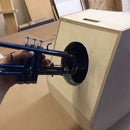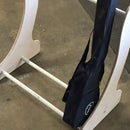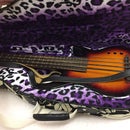Introduction: Build a Battery-Powered Amp for an Old Carbon Mic
A friend of mine acquired a 1970's aviation-style headset for use as a live gaming prop. This Instructable documents the development and construction of a stand-alone amplifier and general-purpose adapter for it. I was much aided in my task by other Instructables, as well as helpful hints in various audio forums.
Step 1: Breadboarding
The first problem to solve is that carbon-button microphones, like condenser mics, need an external source of power. A battery and a resistor in series with the mic gets you a current loop (the resistor limits the current) and then you can pick off the audio at any two points with a voltage drop between them. A single AA battery and a 1K resistor is enough to get a signal you can pick up with a mixer or an audio interface.
To get the rest of it, I bought up several fresh Jim-Packs of capacitors and resistors in useful-sounding values, opened up the National Semiconductor datasheet on the LM386, and started playing. When I got in trouble (which was most of the time) back-posts in random audio forums gave me new ideas to try. One of these led me to a zobel filter, and Wikipedia (of all things!) told me how to make a passive low-pass filter.
Okay, I still think you can do better with the same resources. There are lots of good circuit diagrams floating about the net. But here's my schematic anyhow (see below).
Step 2: Transfer to Protoboard
Once it is working on the breadboard, record everything for transfer to the more permanent circuit board. Don't forget to note the polarity of components like electrolytic capacitors and LEDs!
Protoboard is "perf" board with a copper pattern on one side. The copper is laid out similarly to how a good breadboard is laid out. It is much easier to connect up IC's on a protoboard; the copper brings out the leads for easier soldering, and you have several bus strips available for ground and supply voltage runs. Even Radio Shack has the stuff, and it can save a lot of time. It isn't as tight as conventional perf, though...and for really small spaces nothing beats "dead bug" construction.
For this circuit, all the connections that weren't made by the existing protoboard were done with colored hook-up wire. Make it a point to color-code connections; it is so much simpler to diagnose and repair wiring that is self-documenting! In this case, the color is matched to the bundles going to the jacks and front panel switches.
Always socket IC's. Sockets are cheap. Integrated circuits may be cheap-ish, but they are a pain to de-solder and remove when you've managed to cook one with a bad solder job. Use a socket.
Here's another trick; take a highlighter pen, and as you work through the circuit diagram, check off each component and each connection by highlighting them.
Step 3: Lay Out the Case
This starts with a metal "project box" bought at the local electronics hobby store. The knobs came from the same place -- or you can salvage for that good vintage look.
We all know how to design a case. Collect the knobs and switches, balance them on top or stick them on with masking tape, and move them around until you like the arrangement.
However, a tight case like this requires a little more planning. I used a millimeter ruler to check the footprint of each component as it protruded into the case, and drew their outline on to masking tape stuck inside the case. Don't forget to allow for clearance for the wiring harness as well! (that nearly got me on this project).
Step 4: Mount the Hardware
Cover the areas where the drilling is to take place with masking tape, use rules and straight-edges to make centers, and use a center punch if you have one to tap the holes for better centering of the drill. For larger holes, start with a pilot bit (a small drill bit) and then enlarge. If the drill gets caught in the thin material, reverse it to break the chip loose. Finish up the holes with rat-tail file.
Note that all the components have leads soldered to them before they are mounted. Also, the leads are grouped/twisted/bound to keep them neat. They are also color-coded.
In the final step, the wires are cut to size (leaving a generous slack to make it possible to pull the case apart and replace the battery) and then bundle by bundle led into the protoboard. For this project, I did not use any connectors. That meant I couldn't test the circuit before mounting it in the case. For any more complicated project, some way to disconnect the wires is a must.
Step 5: Finishing Up
There are always new mistakes to be made.
The LED bezel has a rubber insert designed to be slid over the LED's leads. I forgot and soldered the LED. Fortunately, the insert could be sliced lengthwise with an X-acto knife and squeezed around the leads and it worked just fine.
The speaker had no mounting holes, and the bots from the decorative grill stuck out. I cut a piece of black foam-core to space the speaker out, epoxied that to the case, and then epoxied the speaker to that. I should have used barge cement; it works great but is remove-able. All of this brought the speaker out another 6mm from the case, though, forcing me to move the circuit board back before it would fit.
The final sound of the mounted speaker was too good. I went back inside and snipped the lead on one of the filter capacitors to bring some of the high-frequency harshness back.
The LM386 gets very hot when the speaker is run full-out. Remember I said you could easily design a better circuit? Next project, I'll either leave room for a heat sink, or I'll plan to have it up against the metal case so I can use that as a heat-sink.
The equipment case handle I bought at the same store as the case turned out to be slightly too long. There wasn't room for the mounting hardware! As it happened, setting it at an angle looked better anyhow. Always be on the lookout for this kind of lucky mistake!
For the future? This is the same electrical standard as old telephone sets; this same box will pick up and amplify an old telephone handset. I expect to be using this for a sound effects project within the year. I also learned how relatively simple LM386 audio circuits are -- if you are looking for "interesting" sounds, that is. Hi-fi this isn't!













